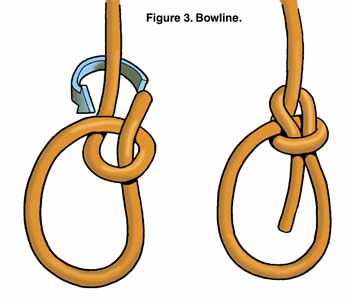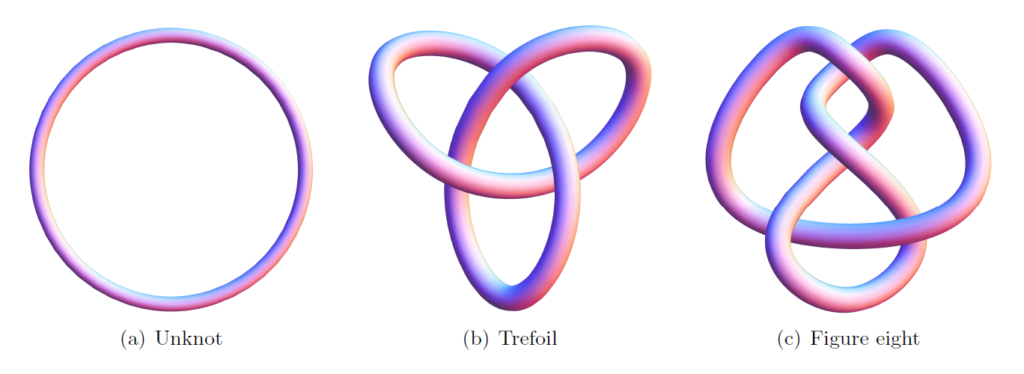Knots are like guitar chords: You can rock n’ roll with three knots and the truth.
A minimalist could muddle through life with one knot: The bowline can be used as a loop, hitch or bend. It can be tied with one hand and its variations perform a wide range of duties. Double it for critical work.

To rock n’ roll learn two more knots: The buntline Hitch1 and the double sheet bend2.


It’s incredible what can be done with these Big Three knots. Practice them into your hands and rock n’ roll through most of life’s rope problems.
Do you prefer Jazz? It won’t take many more knots to improvise like a pro. This “Knots for Life” series will optimize your path with a practice list, improvisation techniques, rules of thumb and real life examples.
Whether you stay with The Big Three or branch out some truths about knots and ropes will set an optimal tone for the webs you weave. There are good reasons, even for a minimalist, to learn a few more.
Less is Three Times More
Knots are elegant tools that multiply the uses of rope. The right combination can transform an ordinary rope into the optimal tool for an endless variety of tasks. As much as I love tying them there are good reasons for minimizing the number used because . . .
Knots Weaken Rope
Knots weaken the rope they’re made from. Where strength is critical minimize knots even to the point of using non-rope materials.
Circus, Circus in Las Vegas uses metal, grommets and cables for their permanent circus installation. Ropes and lines are reserved for nets and swings that come into contact with the performers hands and skin. Braids, splices and loops are stronger than knots. Consider using them instead of a knot. There may not be time to braid or splice, but, why knot when you can loop?
When a knot is the right tool choose ones that are strong, secure (Won’t slip), stable (Won’t capsize), easy to tie and untie.
Knots are Hard to Remember
You’re better off with one knot you can tie than 10 you can’t remember. Keep a knot card in your wallet and two lines of paracord in your pocket. Practice The Big Three into your hands. Muscle memory ties when spatial memory fails. Speaking of which . . .
Knots Must Often Be Tied Upside Down and Backwards
The one knot you can remember may have to be tied hanging upside down, with one hand, in the dark or with:
- Only one rope end available
- No ends available (In the middle of the rope)
- One or both ends under tension
Confidence gained in the living room with knot cards can be quickly dashed. The Big Three won’t handle all these situations. It’s best to anticipate, add a few knots to your list and practice them from different vantage points and without looking.
Ropes Vary Greatly
Rope problems often present with two ropes that are:
- Thick-to-thin
- Slippery-to-dry
- Flat-to-round
- Flat-to-flat
- Bungy-to-vine
- Vine-to-vine
- Vine-to-object
- paracord-to-paracord
- paracord-to-shoelace
- paracord-to-rope
- dental floss-to-bungy
- shoelace-to-rope
- And on and on with every rope material on earth.
Ironically, a weak rope knot may be a strong vine knot, and vice versa. Once again, The Big Three can’t be expected to handle every type of rope.
Less is still three times more, but, there are practical reasons to learn a few more knots than The Big Three.
“. . .extreme simplicity can only be had at the expense of effectiveness.”
– Brion Toss – The Rigger’s Apprentice, 1984
1I like the clove hitch for quick undemanding tasks like securing the ends of a lash or keeping rope off the ground while barbecuing. But, I wouldn’t use a clove hitch to tie my dog’s leash around a pole. Why? Because I love my dog. Why use a clove hitch when you could tie a buntline for the same time and effort? Besides, the buntline has two clove hitches facing the loop, is only a slightly weaker replacement for an anchor bend and if made with with a full loop is hands down stronger than a loop with 2 half-hitches. The first paragraph of this article presents three knots with the widest range of utility for some who may not be interested in going any further than these three. With these criteria in mind? No clove hitch, no way.
2Why a sheet bend instead of a double fisherman’s bend? Frankly, I prefer the double fisherman, but, there are so many situations where two different sized ropes must be joined that a person who doesn’t have The sheet bend in their hands will come up short. Notice I specify the double sheet bend. If you’ll only have one bend under your hands then the 7-10% extra strength is prudent.
Stay tuned for “Knots for Life – Part 2”:
- Knots for Life – Part 2: Wide Before Deep Practice List




